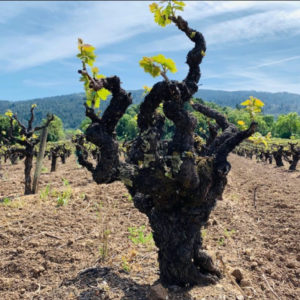Drought Puts Greater Emphasis on Water Use Management
 The current drought conditions are causing a lot of distress around California, especially among farmers. Winery owners and grape growers in Napa Valley are naturally concerned, although some are sleeping better than others.
The current drought conditions are causing a lot of distress around California, especially among farmers. Winery owners and grape growers in Napa Valley are naturally concerned, although some are sleeping better than others.
It’s estimated about 10% of the grapes grown in Napa Valley are dry farmed, i.e. where natural precipitation, not irrigation, provides the water to nourish the vines and produce the grapes. This includes a handful of Calistoga AVA wineries which have been dry farming for decades, such as Chateau Montelena, Jack Brooks Vineyard and Canard Vineyards.
At Canard, Rich Czapleski said his six-acres of old vine Zinfandel were the original non-irrigated vineyard when he and his wife, Carolyn, bought the property in 1983. “About 15 years ago after another drought, we decided to take all the vines off irrigation,” Rich said. Over the next three years they slowly cut back on watering and it worked – through wet and dry years, Canard has continually enjoyed successful harvests.
Another long-time grower whose family has been dry farming since 1929 in the Calistoga AVA near Dunaweal Lane said he’s a mix of a “traditionalist” and “stubborn farmer.” He added: “I know we’re doing the right thing though, as wineries pay premium prices for our grapes.”
Dry Farming Through the Years
Although interest in dry farming has grown in recent years, this is hardly a new or radical vineyard practice. Old World wines – from France, Italy, Spain, etc. – have relied solely on rainfall for centuries. The European wine industry mandates dry farming as part of their appellation designation requirement. With the changing climate though, countries have eased the restrictions on irrigation since 2013, allowing watering in vine survival situations. The other exception is irrigation is permitted with newly planted vines. By nursing the young vines, the hope is to coax the roots to spread deep into the soil to find the moisture and minerals to survive and thrive.
California and New World vineyards originally adopted dry farming as widespread irrigation wasn’t introduced until the 1970’s. According to Bo Barrett of Chateau Montelena, the devastating drought of 1988-89 changed the game. “The vines really suffered during those years … they needed irrigation to survive. Everybody in the valley began irrigating,” he said.
Wineries embraced irrigation especially after seeing the substantial increases in harvest yields. Only in recent years after successive droughts with groundwater drying up – forcing wineries to truck in water – has interest in dry farming returned. The challenge is there are a lot of factors to consider before a grower decides to rely solely on nature’s bounty of enough rainfall to grow the grapes. These include: the soil type (clay retains water vs. sandy soil), vineyard spacing, rootstock, grape variety, etc.
Using Technology to be Water-Wise
Instead of completely turning off the spigots, many wineries are adopting a hybrid approach, relying less on irrigation and turning to technology to reach water-use reduction goals. Barrett said their hillside vineyards in rocky soils need supplemental water to produce fruit. At Montelena they rely on a phone app that allows them to walk through the vineyards and take photos of leaves. “The pictures reveal if the vines are experiencing water stress,” he said. “We know immediately when to water or not.”
Other wineries are incorporating soil moisture monitors to measure each vine’s health, upgrading irrigation systems, utilizing better cover crops, and using drones and satellites for better insight on their vineyards. The new philosophy is to conserve and optimize water use – distributing not a drop more. “Measuring the proper amount of water stress and vine health takes experience and water use management,” Barrett said.
Asked if he was concerned about the current drought conditions, Rich Czapleski of Canard Vineyard shrugged and said, “No, there’s not much I can do anyhow.” For Rich and other dry farmers, Mother Nature always has the final say.